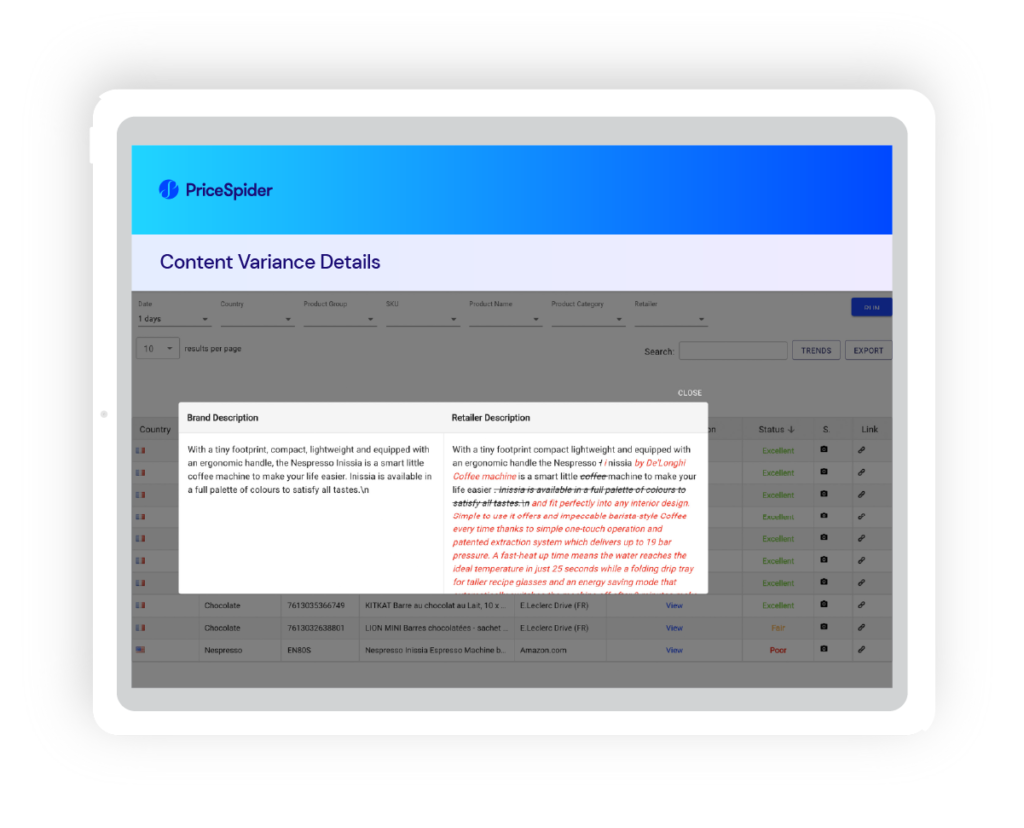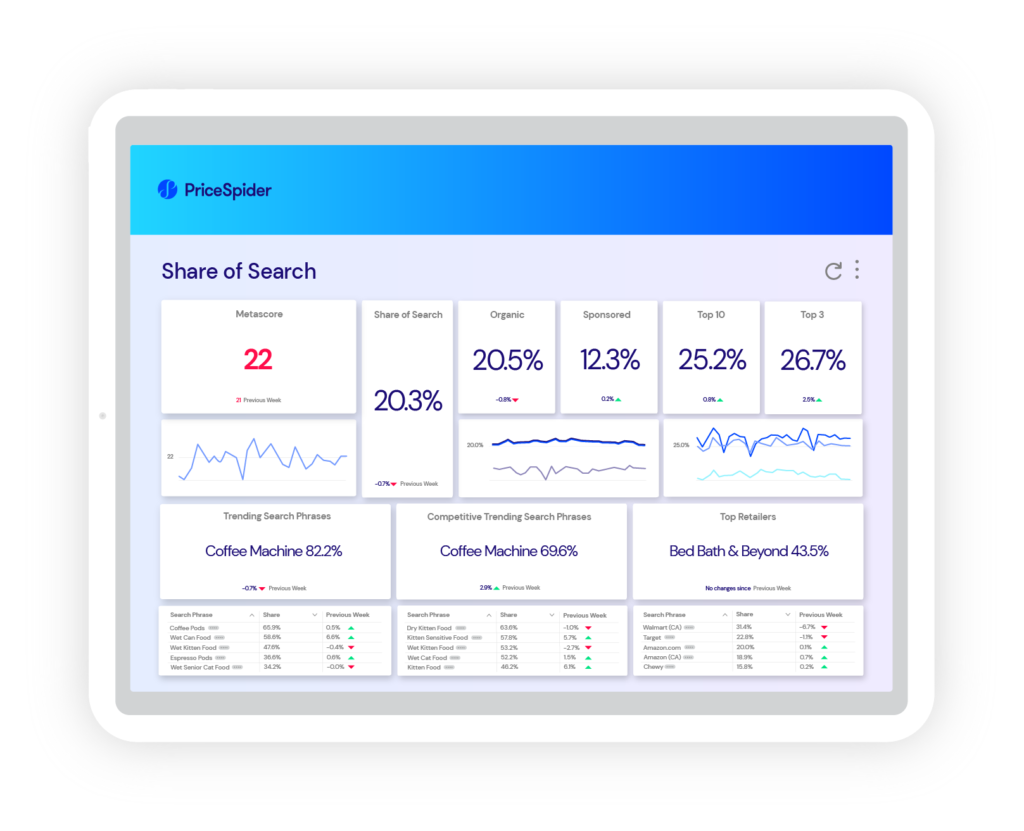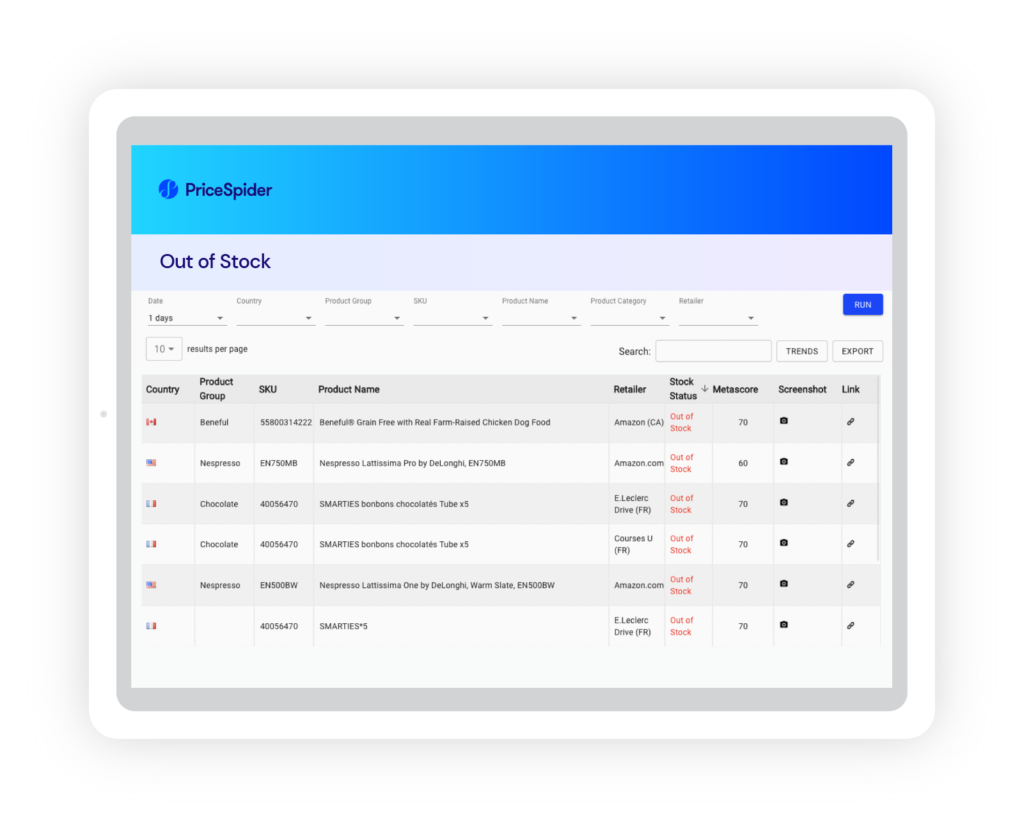Aren’t our five senses great? We can spot armed assailants, hear approaching trains, smell running gas, taste spoiled milk, and feel burning coals under foot. Now which sense is it that’s supposed to keep us from breaking our necks walking up stacks of milk crates? In any case, as you begin losing senses, life gets more difficult. You start smacking into walls, walking into traffic, petting skunks, eating deep fried shoes, dancing naked in cactus patches, and still walking up stacks of milk crates. It turns out, without digital shelf analytics, many brands are left just as helpless.
Digital shelf analytics is the ongoing process of analyzing ecommerce data from the digital shelf. While the digital shelf itself is overwhelmingly broad — it includes the entire online shopping experience — digital shelf analytics focuses on performance metrics that pertain to product pages.
These analytics are crucial to every ecommerce brand’s success, but many brands lack the tools and infrastructure to track, measure, and react to them. While you can collect some digital shelf analytics manually, in the world of ecommerce, the volume of data and speed at which it changes makes these manual efforts extremely inefficient.
Ecommerce brands need to be agile to win the digital shelf. You need insight into what your customers encounter when they explore your product category online, and you need to constantly fine-tune your digital assets to strengthen your position on the shelf. Digital shelf analytics isn’t just a passive process of monitoring key metrics, you’re tracking and measuring these metrics in order to take action, otherwise you might find yourself completely lacking any sense of what’s happening on the digital shelf.
In this article, we’ll explore:
- Why digital shelf analytics matter
- What digital shelf analytics should measure
- How to implement and use digital shelf analytics
Why is digital shelf analytics important?
Ecommerce already stretches your brand in too many directions, forcing you to make difficult decisions about where to invest your time, tools, and talent. So why should you devote resources to digital shelf analytics? Because without it, your products may wind up buried at the bottom of the shelf.
Here are some of the reasons top ecommerce brands are investing in digital shelf analytics.
Evaluate your digital performance
On a basic level, digital shelf analytics helps you determine where you stand in relation to your competitors and how well your digital assets are representing your brand. Every ecommerce site has its own ecosystem where brands and sellers compete to look like the best choice in their category, according to how the site categorizes products, how their customers navigate those categories, and what the store’s search engine favors.
Digital shelf metrics reveal insights into your brand’s performance. If you aren’t tracking them, it’s like driving without a speedometer or a fuel gauge — you’re missing vital inputs and could be moments away from crashing. You can’t simply look at sales and understand what’s happening on the digital shelf. You need to know who’s winning the search engines, how your product pages vary from site to site, where your distribution network needs patching up, and what’s happening to the traffic you send to each seller.
Find opportunities your competition can’t see
Digital shelf analytics goes beyond simply measuring data points. Savvy ecommerce brands use that data to gain a competitive advantage. Say, for example, that you’re equipped to track when your competitors are out-of-stock. The moment their product is no longer available through a retailer, you have a timely opportunity to pounce on their branded search by doubling down on ads. When customers search for that competitor by name and see that it’s out-of-stock, your brand can show up as the next-best alternative.
Or suppose a particular brand has recently been receiving a lot of low ratings. That could be an indicator that there’s a larger problem worth looking into. If their recent poor reviews all highlight the same issues with the product or the experience, it might be worth highlighting how your brand or product prevents this issue from occurring. Digital shelf analytics elevate opportunities like this to give you a competitive edge.
Increase your brand’s visibility
One of the biggest benefits of digital shelf analytics is that it helps you make your products more discoverable and strengthens your online presence. You have the data to determine what’s winning in search engines across the board and optimize your product pages around these trends. You can identify the websites where you’re underperforming and detect variations that could be inhibiting your visibility.
Improve conversion rates
Conversion rates are one of the most vital metrics you can measure. They demonstrate how effectively a given asset is turning consumers into customers. In ecommerce, not only do you need to monitor how changes to a product page impact your conversion rates, but you also need to pay attention to how your conversion rates vary from one seller to another.
When you sell products through a retailer or marketplace, your copy, imagery, and other assets aren’t the only things that influence conversion rates. The seller has a significant impact on the customer experience, too. If your product pages are the same everywhere you sell, but your conversion rates aren’t, that’s not necessarily a reflection of your brand’s persuasiveness. It is, however, an opportunity to improve your overall conversion rates by driving a larger share of traffic to your most effective partners.
Retailers and marketplaces don’t make this data available to you, so the only way you can get it is with digital shelf analytics tools that track the traffic you send to retailers and the transactions that result from it.
Strengthen your brand integrity
Imagine you’re applying for the same job at five different organizations. In each application, you introduce yourself and explain your strengths and weaknesses in slightly different ways. They may all be technically accurate representations of yourself, but they each leave a different impression, and one of those representations of yourself is going to be more effective than the rest.
That’s why maintaining and strengthening your brand integrity is so important. You want to ensure that wherever consumers find your brand, they end up with the same impression of you, and they always see the strongest representation of your products.
Inconsistencies from one product page to another can negatively impact your conversion rates and misrepresent your products (especially if there are outdated assets). If anyone is shopping around specifically for your product, these variations may make them feel like some product pages aren’t legitimate.
Digital shelf analytics helps you monitor each seller’s content compliance so you can spot holes in your brand integrity before they grow into bigger problems.
Influence your product category
When you’re the first brand consumers encounter when they explore your product category, you’re in a position to influence the features and qualities consumers see as most important, shaping how they’ll perceive your competitors and think about their goals. Stay on top for long, and you’ll inevitably see other brands attempt to emulate you. Keep analyzing and optimizing your position on the digital shelf, and other brands in your space will be stuck playing catch up forever.
What do digital shelf analytics measure?
Technically, digital shelf analytics can systematically measure and analyze just about any metric that relates to the online customer experience. But you want to focus on actionable data you can use to evaluate and improve your position. For ecommerce brands, the most crucial metrics include:
- Content compliance (titles, descriptions, and imagery)
- Share of search
- Ratings
- Number of sellers per marketplace
- Stock status
- Conversion rate
- Traffic
- Cart abandonment rate
To learn more about each of these metrics, check out these seven digital shelf analytics metrics every brand should monitor.
Depending on the metric you’re analyzing, it may be more pertinent to see these data points in real time or during a specified period. A top-tier digital shelf analytics solution should enable you to explore each metric in the most useful ways.
Real-time data
Some digital shelf metrics require quick reactions to capitalize on the opportunities they present. Suppose an immensely popular competitor runs out of stock on Target.com. Your window could be hours or days, but if enough people look for this competitor at Target, you could poach sales from their branded search every minute! If your tools only pull data a couple times per day, you’re missing out.
Change over time
Isolating date ranges and examining metrics over time helps you spot trends you can’t see by simply looking at aggregate real-time data. For example, if your product has thousands of reviews, a batch of one-star ratings isn’t going to have much impact on your overall rating, but if your average rating over the last few weeks or months looks significantly lower than your overall average, it could be a sign that there’s a problem you need to explore.
The same is true for other metrics like share of search. You don’t necessarily just want to see where you’re at right now, you want to see if you and your competitors are gaining or losing ground.
How do you “do” digital shelf analytics?
Most brands aren’t equipped for digital shelf analytics. They don’t have the tools, time, or talent to collect the data they need and draw actionable insights from it. Some of the data you need to analyze is only available through specialized software. And even the data you can collect manually — like ratings, stock status, content compliance, or your position in search results — is difficult to organize in meaningful ways or keep current.
To make use of digital shelf analytics, ecommerce brands need to:
- Automate data collection
- Dedicate employees to the process
- Optimize digital touchpoints
- Develop a digital shelf strategy
Automate data collection
The volume of data brands can collect is both immensely useful and incredibly intimidating. When you have thousands of SKUs and hundreds of sellers, it’s impossible to keep up with real-time data collection. You could dedicate an entire department to the process and still have gaps. Digital shelf analytics solutions like PriceSpider’s Brand Monitor can collect real-time data for your entire catalog from thousands of online retailers and more than 20 online marketplaces.
Everything Brand Monitor collects, you can explore in an intuitive dashboard, making it easy for you to turn information into insights.
Evaluating content compliance is a breeze. Brand Monitor shows you how well each product page follows your guidelines, flags any variations it finds on the web, and gives every page a compliance score.

Brand Monitor’s share of search dashboard gives you a bird’s-eye view of how well your products are performing in key product-related searches for each retailer, highlighting what percentage of organic and paid search results your products appear in.

You can also track your competitor’s stock status and receive alerts when they’re out-of-stock through a retailer or marketplace that carries your products.

Dedicate employees to the process
If you value your personal health, you don’t wait for an annual physical or major health problem to occur before you take it seriously. You pay attention to what your body is telling you every day about the things you eat and the activities you take on. Similarly, you don’t want to rely on quarterly or even monthly reports to pay attention to your brand’s health. Like diet and exercise, digital shelf analytics is an ongoing process that should impact day-to-day operations.
And for that to happen, you need employees dedicated to the task of reporting on digital shelf metrics, turning those metrics into actionable insights, and looking for opportunities to improve. Otherwise, you’re leaving money on the table — and your competitors may not leave it there.
Optimize your digital touchpoints
The whole point of digital shelf analytics is to understand your brand’s position on the shelf so that you can improve it.
If your rankings fall, you need to investigate why competitors are pulling ahead. How are their titles and descriptions better at aligning with your target keywords? If your ratings are slipping, you need to find patterns in negative reviews so you can correct any issues with your product, shipping, or service. When a competitor is out-of-stock, boost your ad spend and go for their branded keywords. (And when you’re out-of-stock, cut off your ad spend right away!)
Develop a digital shelf strategy
Since digital shelf analytics is an ongoing process of reacting to data and optimizing your online presence, it should feed into an overarching digital shelf strategy. You need to formalize a plan for what happens with your data, who acts upon it, and how it fits into your brand’s other goals and initiatives.
Get a digital shelf analytics solution
Brand Monitor is the definitive digital shelf analytics software. Building on two decades of specialized ecommerce data collection tools, PriceSpider equips your brand with data and insights you can’t find anywhere else. Many of the world’s leading brands rely on our tools, and if you want to get on top and stay there, you need a top-tier digital shelf solution.
Want to see what Brand Monitor can do for your business?

